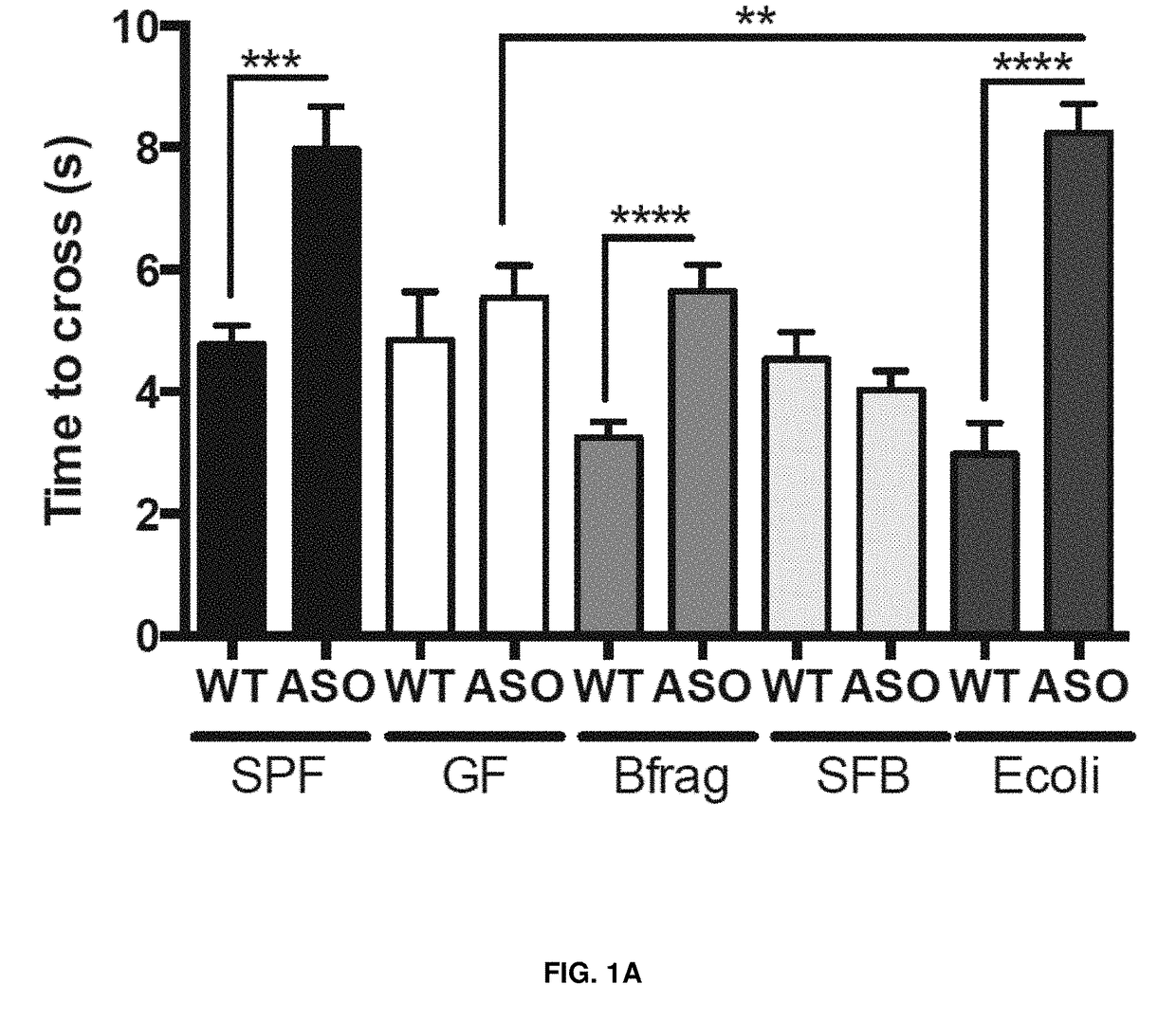Use of gut microbiota in the diagnosis and therapeutics of parkinson's disease
a technology of gut microbiota and parkinson's disease, applied in the direction of biochemistry apparatus and processes, instruments, material analysis, etc., can solve the problems of serious side effects of treatment and often lose effectiveness, and achieve the effect of improving motor deficit, and reducing the likelihood of onset of parkinsonism
- Summary
- Abstract
- Description
- Claims
- Application Information
AI Technical Summary
Benefits of technology
Problems solved by technology
Method used
Image
Examples
example 1
[0044]As shown in FIGS. 1A-F, wild-type (WT) or α-synuclein overexpressing (ASO) mice were monocolonized with Bacteroides fragilis (Bfrag), segmented filamentous bacteria (SFB) or Escherichia coli (E. coli). Animals were tasked with (FIG. 1A) traversing a balance beam, (FIG. 1B) removing an adhesive from the nasal bridge, or (FIG. 1C) hindlimb reflexes were measured. Only ASO animals colonized with a complex microbiota (SPF) or with E. coli displayed significant motor deficits. Similarly, ASO animals colonized with E. coli lacking the curli-amyloid (ΔcsgBAC) do not display significant motor deficits in the (FIG. 1D) beam, (FIG. 1E) adhesive removal, or (FIG. 1F) hindlimb reflexes compared to animals colonized with wild-type, amyloid producing E. coli (WT). This data shows that monocolonization with amyloid-producing E. coli is sufficient to promote synuclein-mediated motor dysfunction.
example 2
[0045]As shown in FIGS. 2A-B, wild-type (WT) or α-synuclein overexpressing (ASO) mice were intra-intestinally injected with wild-type, amyloid-sufficient (e.g., amyloid-forming) CsgA peptide (+CsgA) and motor function was measured over time in the (FIG. 2A) beam crossing and (FIG. 2B) adhesive removal test. ASO mice injected with CsgA displayed worsened motor function compared to non-injected (Sham). Additionally, injection of a mutant CsgA peptide, which cannot form amyloid (N122A), did not induce motor deficits. Surprisingly, WT animals, not predisposed to motor dysfunction, also displayed a decrease in motor function when treated with CsgA, but not the N122A mutant. This data shows that intra-intestinal injection of amyloid-sufficient curli peptide promotes worsened motor dysfunction.
example 3
[0046]As shown in FIGS. 3A-G, wild-type B6 mice were intra-intestinally injected with either wild-type CsgA peptide or the N122A mutant, and motor function was measured over time. Mice treated with CsgA, but not the mutant, displayed significant motor dysfunction in the (FIG. 3A) beam crossing, (FIG. 3B) adhesive removal, and (FIG. 3C) hindlimb reflexes. Fecal output also began to decline over time (FIGS. 3D-F). Further, treatment of Tlr2− / − mice (Tlr) with CsgA peptide did not induce significant motor deficits in the beam crossing assay (G). This data shows that CsgA is sufficient to induce motor dysfunction in wild-type animals.
[0047]While various aspects and embodiments have been disclosed herein, other aspects and embodiments will be apparent to those skilled in the art. The various aspects and embodiments disclosed herein are for purposes of illustration and are not intended to be limiting, with the true scope and spirit being indicated by the following claims.
PUM
| Property | Measurement | Unit |
|---|---|---|
| nucleic acid sequencing | aaaaa | aaaaa |
| size | aaaaa | aaaaa |
| aggregation | aaaaa | aaaaa |
Abstract
Description
Claims
Application Information
 Login to View More
Login to View More - R&D
- Intellectual Property
- Life Sciences
- Materials
- Tech Scout
- Unparalleled Data Quality
- Higher Quality Content
- 60% Fewer Hallucinations
Browse by: Latest US Patents, China's latest patents, Technical Efficacy Thesaurus, Application Domain, Technology Topic, Popular Technical Reports.
© 2025 PatSnap. All rights reserved.Legal|Privacy policy|Modern Slavery Act Transparency Statement|Sitemap|About US| Contact US: help@patsnap.com



